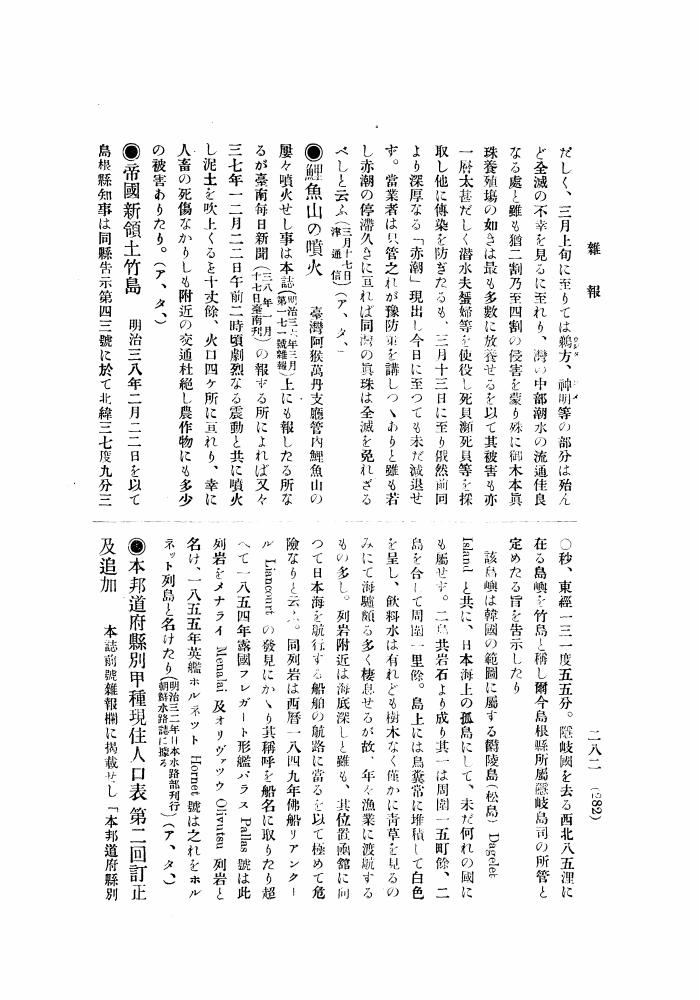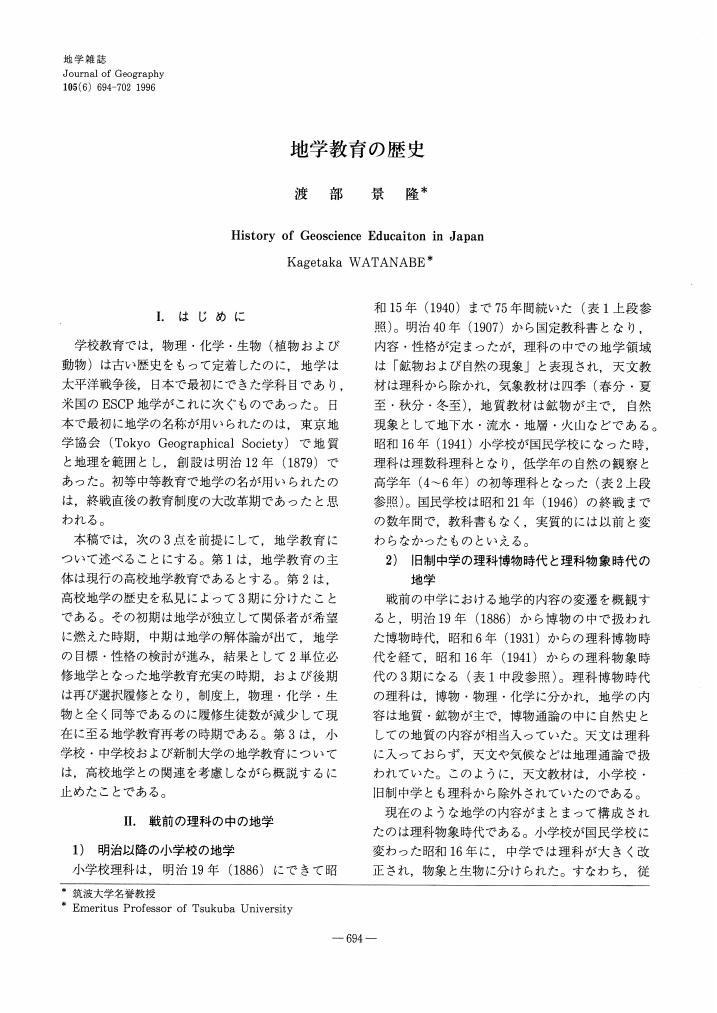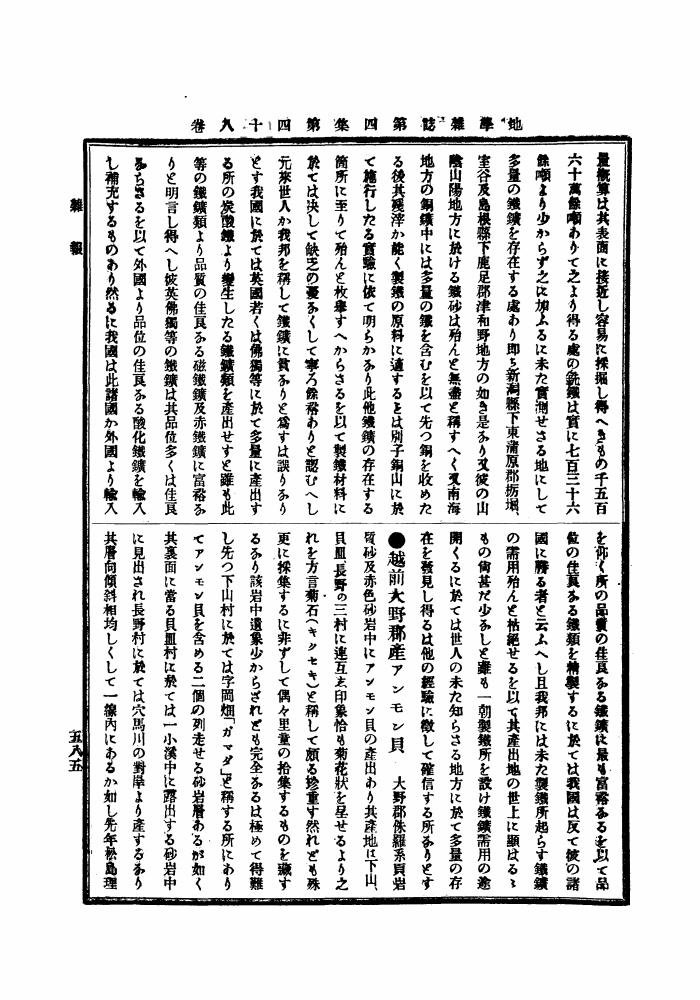4 0 0 0 OA 歴史地理學とは何ぞや
- 著者
- 山崎 徳
- 出版者
- 公益社団法人 東京地学協会
- 雑誌
- 地学雑誌 (ISSN:0022135X)
- 巻号頁・発行日
- vol.45, no.2, pp.101-103, 1933-02-15 (Released:2010-10-13)
4 0 0 0 OA 神奈川県江の島の離水波食棚と1703年元禄関東地震時の隆起量
- 著者
- 松田 時彦 松浦 律子 水本 匡起 田力 正好
- 出版者
- 公益社団法人 東京地学協会
- 雑誌
- 地学雑誌 (ISSN:0022135X)
- 巻号頁・発行日
- vol.124, no.4, pp.657-664, 2015-08-25 (Released:2015-09-17)
- 参考文献数
- 18
- 被引用文献数
- 3
There are two emerged abrasion platforms on Enoshima Island, Kanagawa Prefecture, Southern Kanto district: the 4.0-meter-high Ryoshimachi surface, and the 1.0–1.3-meter-high Iwaya surface. Both emerged prior to the 1703 Genroku Earthquake. Considering uplift due to the 1923 Taisho Kanto Earthquake and non-seismic subsidence since the Genroku Era, uplift due to the 1703 Genroku Earthquake was 0.7 m or less, assuming that the height of Ryoshimachi surface before the Genroku Earthquake was 3 m or higher. This indicates that uplift of the Genroku Earthquake at Enoshima was smaller than that of the Taisho Earthquake, and the focal regions of the two earthquakes were different in the Sagami Bay. These two earthquakes are not repeating earthquakes at the Sagami Bay area.
4 0 0 0 OA 南極における無人航空機(UAV)を用いた高解像度地形情報取得の試み
- 著者
- 菅沼 悠介 川又 基人 白水 薫 小山 拓志 土井 浩一郎 金田 平太郎 青山 雄一 早河 秀章 小花和 宏之
- 出版者
- 公益社団法人 東京地学協会
- 雑誌
- 地学雑誌 (ISSN:0022135X)
- 巻号頁・発行日
- vol.126, no.1, pp.1-24, 2017-02-25 (Released:2017-04-20)
- 参考文献数
- 36
- 被引用文献数
- 6
Unmanned aerial vehicle-based “Structure from Motion” (UAV-SfM) photogrammetry is becoming increasingly important for obtaining high-definition topographic data in a variety of earth science research. Antarctica is one of the best fields in which UAV-SfM surveys are applied, because detailed geomorphological data are essential for reconstructing past Antarctic ice sheet changes and understanding landform evolution processes in a hyper-arid and hypothermal environment. However, application of UAVs in Antarctica has been limited because of difficulties arising from low temperatures and the restricted availability of the Global Navigation Satellite System (GNSS)-assisted navigation system at high latitudes. In this article, we provide methodological solutions for these difficulties, and report several preliminary results of UAV surveys in central Dronning Maud Land and the Soya Coast in East Antarctica. A digital elevation model (DEM) obtained in central Dronning Maud Land clearly shows 3D structures of polygons developed on glacial tills. At the Soya Coast, a DEM analysis reveals detailed geomorphological characteristics, such as moraine ridges originating from a former ice stream and differential erosion of the basement due to weathering. Based on these results, we suggest that the UAV survey has certain merits for conducting an efficient field survey in the extremely large areas of Antarctica within a limited time, and has great potential for reconstructing past Antarctic ice sheet changes and obtaining a further understanding of landform evolution processes.
4 0 0 0 阿蘇山噴火概表
- 著者
- 大森 房吉
- 出版者
- Tokyo Geographical Society
- 雑誌
- 地学雑誌 (ISSN:0022135X)
- 巻号頁・発行日
- vol.32, no.3, pp.116-124, 1920
- 著者
- 加瀬 友喜
- 出版者
- 公益社団法人 東京地学協会
- 雑誌
- 地学雑誌 (ISSN:0022135X)
- 巻号頁・発行日
- vol.105, no.4, pp.512-515, 1996-08-25 (Released:2009-11-12)
- 参考文献数
- 19
4 0 0 0 OA 梁山断層 (韓国東南部) 中央部の活断層地形とトレンチ調査
- 著者
- 岡田 篤正 渡辺 満久 佐藤 比呂志 全 明純 曹 華龍 金 性均 田 正秀 池 憲哲 尾池 和夫
- 出版者
- 公益社団法人 東京地学協会
- 雑誌
- 地学雑誌 (ISSN:0022135X)
- 巻号頁・発行日
- vol.103, no.2, pp.111-126, 1994-04-25 (Released:2010-10-13)
- 参考文献数
- 51
- 被引用文献数
- 12 39
Many distinct lineaments have been recognized by Landsat images in Korean Peninsula. The Yangsan fault system situated in the southeastern part of Korea is especially linear, continuously traceable for a long distance (about 200km), and particularly remarkable among these lineaments. The topographic expression of the Yangsan fault system is derived from the straightly stretching fault valley with wide shattered zones in the direction of NNE-SSW. This fault system extends for about 200km from the mouth of the Nagdong River west of Busan in the south to Yeondong in the north, and geologically separates Korean Peninsula from the Japan Sea. The amount of horizontal displacement may reach 30km. It is recognized as one of the most important faults in Korean Peninsula.From the interpretations of aerial photographs, and field surveys along the central part of the Yangsan fault system, the main results are summarized as follows:1. The Yangsan fault system has repeatedly moved in the late Quaternary. The lower to higher river terrace surfaces on this system show cumulative vertical offsets.2. The vertical component is upthrown on the east side from considering the terrace offset and the distribution of the mountainous lands. This vertical movement is reverse to the topographical situation on the meso-scale.3. The fault trace is extremely straight. The fault plane is almost vertical. The shatteredzone exceeds tens of meters in width with a remarkable fault gouge.4. The longer axis of flat clasts within the gravel observed in excavated the exploratory trench showed the re-arrangement along the fault. The predominantly right-lateral movements were recognized as the elongation of clayey parts and breccias in the fault gouge.5. From these characteristics, the Yangsan fault was clarified to be active with predominantly right-lateral movement. Estimated ages of terraces and its deposits give average rates of vertical and right slip on the Yangsan fault system at about 0.02-0.03mm/y, and at least 0.05-0.1mm/y, respectively.6. The fault topography is not found on the lower and lowest terraces. As the surface of the terrace has widely been cultivated as paddy fields for long historical time, lower fault scarplets less than a few meters high might have been modified or destroyed by the human actions. Therefore, we cannot mention the existence of the younger movement on the lower and lowest terraces.
4 0 0 0 OA 2つに裂けながら首都圏下に沈み込むフィリピン海プレート
- 出版者
- 公益社団法人 東京地学協会
- 雑誌
- 地学雑誌 (ISSN:0022135X)
- 巻号頁・発行日
- vol.122, no.3, pp.Cover03_1-Cover03_3, 2013-06-25 (Released:2013-07-08)
- 参考文献数
- 2
(表面)太平洋プレート上部境界面から10km上方の曲面(地表面からほぼ40–120kmの深さ範囲)に沿うS波速度の分布(Nakajima and Hasegawa, 2010).S波速度をカラースケールで示す.太平洋プレートとフィリピン海プレートの接触域を2本の太い黒破線で囲んで示す.赤星印は1885年以降に南関東で発生した5つのM7級地震.ビーチボールは1921年竜ヶ崎地震(M7.0)(2通りの解を示す)と1987年千葉県東方沖地震(M6.7)のメカニズム解.黒丸は1987年千葉県東方沖地震の余震.(裏面)フィリピン海プレート東端部の蛇紋岩化域(茶色の領域).ピンク色の太い破線は蛇紋岩化域の西縁.フィリピン海プレート上面の深さ分布を灰色破線のコンターで示す.緑色の四角と丸は太平洋プレート上部境界面で発生した地震,灰色の点はフィリピン海プレートマントル内の地震.1921年竜ヶ崎地震と1987年千葉県東方沖地震に加え,フィリピン海プレートのマントル内の4つの地震のメカニズム解もビーチボールで示す.紫色の丸は1923年関東地震の約30時間後に発生したM7.1の余震.フィリピン海プレートはピンク色の太い破線を境にして2つに裂け,東側の蛇紋岩化域は西側の本体部分からとり残され,より遅い速度で沈み込んでいる.ピンク色の細い破線で囲んだ楕円はOkada and Kasahara(1990)が指摘した地震の空白域.(長谷川 昭)
4 0 0 0 OA 海洋地殻の磁化 : 海洋地磁気縞状異常の起源について
- 著者
- 木川 栄一
- 出版者
- 公益社団法人 東京地学協会
- 雑誌
- 地学雑誌 (ISSN:0022135X)
- 巻号頁・発行日
- vol.104, no.3, pp.381-391, 1995-06-25 (Released:2009-11-12)
- 参考文献数
- 29
The location of the magnetized rocks of the oceanic crust that are responsible for sea-floor spreading magnetic anomalies has been a long-standing problem in geophysics. The recognition of these anomalies was a keystone in the development of the theory of plate tectonics. Our present concept of oceanic crustal magnetization is much more complex than the original, uniformly magnetized model of Vine-Matthwes-Morley. Magnetic inversion studies indicated that the upper oceanic extrusive layer (layer 2A, 0.5 km thick) was the only magnetic layer and that it was not necessary to postulate any contribution from deeper parts of oceanic crust. Direct measurements of the magnetic properties from the sea floor, however, have shown that (i) the magnetization of layer 2A is insufficient to give the required size of observed magnetic anomalies and (ii) some contribution from lower intrusive rocks is necessary. Recent ODP studies reported high magnetization intensities in the gabbroic rocks and the peridotites. The source of the lineated magnetic anomalies must reside in most of the oceanic crust and in the upper portion of upper mantle.
3 0 0 0 OA 帝國新領土竹島
- 出版者
- 公益社団法人 東京地学協会
- 雑誌
- 地学雑誌 (ISSN:0022135X)
- 巻号頁・発行日
- vol.17, no.4, pp.282a, 1905-04-15 (Released:2010-12-22)
3 0 0 0 OA 伊能忠敬による月食観測を用いた経度測定とその精度
- 著者
- 野上 道男
- 出版者
- 公益社団法人 東京地学協会
- 雑誌
- 地学雑誌 (ISSN:0022135X)
- 巻号頁・発行日
- vol.129, no.2, pp.263-274, 2020-04-25 (Released:2020-05-12)
- 参考文献数
- 10
- 被引用文献数
- 2 4
In order to measure the longitude difference between two distant sites, Inoh Tadataka and his technical team observed three lunar eclipses when surveying the Japanese Islands at the beginning of the 19th century, and left some observation records. The local times when the partial eclipses began and ended were measured with a pendulum clock. By introducing the equation of time to the calendar date of the observations, the time difference can be obtained between the local time observed by Inoh and the lunar eclipse timetable of NASA shown in Japanese Standard Time at 135E degrees of longitude. Consequently, the accuracy of the longitude survey performed by Inoh Tadataka is evaluated in comparison to the precise map of the Geographical Survey Institute.
3 0 0 0 OA 遺跡出土朱の起源
- 著者
- 南 武志
- 出版者
- 公益社団法人 東京地学協会
- 雑誌
- 地学雑誌 (ISSN:0022135X)
- 巻号頁・発行日
- vol.117, no.5, pp.948-952, 2008-10-25 (Released:2010-04-27)
- 参考文献数
- 25
The present study represents an attempt to determine the sources of vermilion found in ancient Japanese burial mounds prior to the emergence of the ancient Yamato dynasty. For this purpose, cinnabar ores were collected from Chinese and Japanese mines, and samples of vermilion were also collected from ancient tombs. When the vermilion collected from the tombs was studied morphologically, different particle sizes were observed. However, the particle size of the artificial vermilion was found almost same. The metal contents of cinnabar ores were different for each Japanese mine: Niu (Mie Pref.), Yamato Mercury (Nara Pref.), Sui (Tokushima Pref.), and Itomuka (Hokkaido Pref.) mines. Arsenic (As) content was highest in cinnabar ore from Niu mine; Mn and Fe contents were highest in Yamato Mercury mine; and, the Ba, Ca, Co, Cr, and Sr contents were highest in Sui mine. When analyzing the metal contents of vermilion collected from ancient tombs in Nara Prefecture, vermilion collected from Kurozuka, Kamotsuba, and Tomio-Maruyama tombs showed a high As content, and vermilion from Tenjinyama tomb showed a high Mn content. Thus, the possibility was suggested of identifying the original vermilion mine from the metal contents. However, it is difficult to set borderlines for the metal contents of vermilion to identify the source mine. So, the ratios of sulfur isotope (δ34S) in ores and vermilion were compared. A high δ34S value of +22.6 ± 3.6‰ was found for the ore of Wanshan of Guizhou and from +6 to +10.6‰ for Xunyang of Shaanxi in China, as opposed to low values ranging from -7.3 ± 1.9 to -2.1 ± 1.6‰ for Japanese mines. It is thought that δ34S values are suitable for determining the sources of vermilion found in ancient tombs. In addition, high ratios from +7.4 to +22.8‰ were found in 1st- and 2nd-century burial sites in northern Kyushu and San'in, and lower ratios from -8.4 to -2.0‰ were found in burial sites of the 2nd through 6th centuries in central Japan. Therefore, powerful local chiefs living in northern Kyushu and San'in areas might have obtained vermilion through relations with China, but chiefs living in central Japan might have used vermilion collected from Japanese mines. In conclusion, the sources of vermilion collected in ancient tombs can be determined by measuring δ34S values. An additional analysis of a lead isotope ratio, for example, might also be necessary to determine the source of vermilion.
3 0 0 0 OA 地学教育の歴史
- 著者
- 渡部 景隆
- 出版者
- Tokyo Geographical Society
- 雑誌
- 地学雑誌 (ISSN:0022135X)
- 巻号頁・発行日
- vol.105, no.6, pp.694-702, 1996-12-25 (Released:2010-04-23)
- 参考文献数
- 16
- 被引用文献数
- 2 1
3 0 0 0 OA 鉱物学の夜明け
- 著者
- 田賀井 篤平
- 出版者
- 公益社団法人 東京地学協会
- 雑誌
- 地学雑誌 (ISSN:0022135X)
- 巻号頁・発行日
- vol.131, no.2, pp.133-146, 2022-04-25 (Released:2022-05-13)
- 参考文献数
- 41
- 被引用文献数
- 2 2
The history of mineralogy can be traced back to the Greco-Roman period, from Theophrastos to Agricola. Linné, Cronstedt, and Werner established classical mineralogy. Crystallography developed with mineralogy, and classical crystallography was established by Haüy through Steno. In the 19th century, the discovery of X-rays by Röntgen and the discovery of X-ray diffraction by Laue gave birth to modern mineralogy and crystallography. A little later, electron diffraction was discovered, leading to the invention of the electron microscope. In Japan, Wada laid the foundations for mineralogy and crystallography.
3 0 0 0 OA 日本群島
- 著者
- 原田 豊吉 脇水 鐵五郎
- 出版者
- 公益社団法人 東京地学協会
- 雑誌
- 地学雑誌 (ISSN:0022135X)
- 巻号頁・発行日
- vol.3, no.9, pp.459-465, 1891-09-25 (Released:2010-10-13)
3 0 0 0 OA 越前大野郡産アンモン貝
- 出版者
- 公益社団法人 東京地学協会
- 雑誌
- 地学雑誌 (ISSN:0022135X)
- 巻号頁・発行日
- vol.4, no.12, pp.585-586, 1892-12-25 (Released:2010-12-22)
3 0 0 0 OA 化石の方言
- 著者
- 大上 宇市
- 出版者
- 公益社団法人 東京地学協会
- 雑誌
- 地学雑誌 (ISSN:0022135X)
- 巻号頁・発行日
- vol.7, no.1, pp.55a, 1895-01-25 (Released:2010-10-13)
3 0 0 0 OA 地球發育史試験答案
- 著者
- 石川 一男
- 出版者
- 公益社団法人 東京地学協会
- 雑誌
- 地学雑誌 (ISSN:0022135X)
- 巻号頁・発行日
- vol.3, no.7, pp.368-372, 1891-07-25 (Released:2010-10-13)
3 0 0 0 OA 八丈島, 東山火山のテフロクロノロジー
- 著者
- 杉原 重夫
- 出版者
- 公益社団法人 東京地学協会
- 雑誌
- 地学雑誌 (ISSN:0022135X)
- 巻号頁・発行日
- vol.107, no.3, pp.390-420, 1998-06-25 (Released:2009-11-12)
- 参考文献数
- 40
- 被引用文献数
- 1 3 1
Hachijojima, one of the Izu Islands, is located on the Volcanic front of the Izu-Ogasawara (Bonin) Arc which lies south to north along the boundary of the Pacific plate and the Philippine Sea Plate. Hachijojima consists of two stratovolcanoes : Higashiyama and Nishiyama. There is a sharp contrast between Higahshiyama, which is a well-dissected mountain, and Nishiyama, which is cone-shaped. It is topographically clear that Higashiyama was formed earlier than Nishiyama. The following is a summary of the results of this study.1) The eruptive history of Higashiyama can be divided into six ages : Sokodo I (40-50 ka), Sokodo II (ca. 25-33 ka), Sueyoshi (ca. 17-25 ka), Nakanogo I (ca. 11-17 ka), Nakanogo II (ca. 5.8-11) and Mitsune (ca. 5.8 ka and later).2) At Higashiyama, a large amount of dacitic magma erupted in the Sokodo I Age and the Sueyoshi Age, and formed a caldera. In the Sokodo I age, the early stratovolcanoes were subjected to landslides and collapsed, and the Higashiyama caldera emarged. In the Sueyoshi Age, the summit of Higashiyama stratovolcanoes were subject to landslides and collapsed to form the Nishihakuunzan caldera.3) the Higashiyama stratovolcano (young stratovolcano I) was formed in the Sokodo II Age and Mihara stratovolcano (young stratovolcano II a, b) in the Nakanogo I Age by eruptions of basalt and andesite magma.4) Higashiyama formed a central cone at the end of Nakanogo I Age and eruptions from the summit ended around ca. II ka. Thereafter, it transformed into a flank eruption which issued andesite magma in the Nakanogo II age. In the Mitsune age, volcanic activities of Higashiyama receded.5) In the Nishiyama region, eruptions became active from the Nakanogo I Age and issued mainly basaltic tephra and pyroclastic surges. However, dacitic tephra was also issued. Occasional finding of pumice fall deposit suggest the generation of daciticmagma.6) On Higashiyama, deposits Aira-Tn ash (ca. 24.5 ka) and Kikai-Akahoya ash (ca. 6.3 ka) were transported by westerlies from the Kyusyu area. They prove to be important marker tephras clarifing the tephra stratigraphy and eruptive history in this region.
- 著者
- 山田 俊弘 矢島 道子 須貝 俊彦 島津 俊之
- 出版者
- 公益社団法人 東京地学協会
- 雑誌
- 地学雑誌 (ISSN:0022135X)
- 巻号頁・発行日
- vol.132, no.3, pp.217-230, 2023-06-25 (Released:2023-07-07)
- 参考文献数
- 41
The historiography of geoscience in the 20th century in Japan is reconsidered through 57 volumes of diaries (1914-1963) of Mochizuki Katsumi (1905-1963), a geology professor at Shizuoka University, from the following four viewpoints: 1) Scientific thought of geotectonics: Considering Mochizuki's own theory of geotectonics from his relations with other researchers such as Otuka Yanosuke (1903-1950), professor at the Earthquake Research Institute and the Faculty of Science of the Imperial University of Tokyo; 2) Mutual relationship between geology and geography: Tracing Mochizuki's teachings and research in the two disciplines at the higher schools of Kanazawa and Shizuoka; 3) History of geoscience education: Illustrating the transition of ‘geoscience’ including human geography, from the World War II era to the post-war period; 4) The life history of a scientist: Positioning a personal history, which records details of educational reforms in the history of universities and cultural history of Japan.
3 0 0 0 OA 過去百年間における都市化にともなう東京の生物相の変化
- 著者
- 高岡 貞夫
- 出版者
- 公益社団法人 東京地学協会
- 雑誌
- 地学雑誌 (ISSN:0022135X)
- 巻号頁・発行日
- vol.122, no.6, pp.1020-1038, 2013-12-25 (Released:2014-01-16)
- 参考文献数
- 92
- 被引用文献数
- 4 4
This paper overviews changes in land use and fauna over the past ca. 100 years in and around Tokyo Metropolis. Rapid changes in fauna occurred during the second half of the last century with urbanization. The faunal changes were caused by habitat destruction due to exploitation, habitat change due to urban warming, regime changes in natural and anthropogenic disturbances, and the invasion of alien species. Although a rapid decline of native species diversity occurred during the period, some species have reinvaded or newly invaded urban and suburban areas in the last few decades. Some alien species have also invaded the built environment such as artificial coasts and abandoned coppice forests. Faunal changes continued even after the rapid environmental changes in the last century. Continuous monitoring is needed to detect further faunal changes in the Tokyo area.







